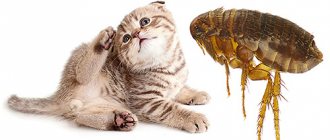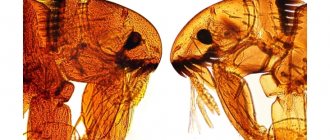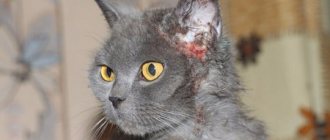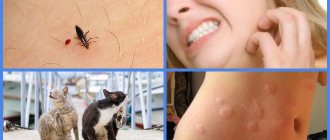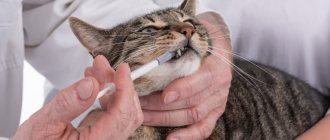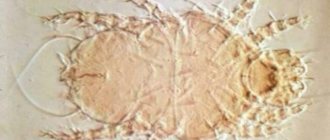A cat is a favorite of the whole family, it brings comfort to our home, gives its owners warmth and joy. For his part, a person must take care of the animal and monitor its health. The main problem that cat owners face is the diseases of their pets, as well as various parasites that often bother them. Fleas are the most common parasite on cats, especially when it comes to animals that walk outside. These require immediate and decisive action on the part of the owner because they seriously undermine their health. These parasites can be carriers of dangerous diseases and pose a danger to humans. They do not live on it, but can feed on its blood through bites.
You can remove fleas from a cat at home, but you should first show the animal to a veterinarian. These pests lead to serious weakening of the animal, in advanced cases it causes anemia, weakens the immune system, which can cause other, more serious diseases. That is why any cat owner should know the first signs of these insects, as well as how to get rid of them.
Cat flea: who is it and where does it come from?
To understand where cats get fleas from, you should learn more about these parasites: their structure, feeding habits, and life cycle. Fleas are a huge order of wingless insects that are blood-sucking exoparasites and parasitize on any animal. They have a rather narrow specialization: there are fleas of rabbits (Spilopsyllus cuniculi), dogs (Ctenocephalus canis), humans (Pulex irritans) and cats (Ctenocephalides felis). These insects also parasitize rats and birds. Outwardly, they are very similar; only a professional entomologist can determine the exact type of insect.
general description
What does a flea look like on a cat? Their body size ranges from 1 to 5 mm, the cat flea reaches approximately 2 mm. Males are smaller than females. The parasite that has sucked blood increases sharply in size—approximately 2 times. The insect's body is flattened laterally (this makes it easy to move between hairs) and covered with numerous spines and bristles. They help the insect to stay between the hairs of fur or feathers.
The oral apparatus of the parasite is of the piercing-sucking type, which includes a special stylet that pierces the skin of the host. They do not have a proboscis. The limbs of the parasite are strong, they give it the ability to move along surfaces at any angle, as well as make long jumps. The abdomen has special tactile hairs that are sensitive to air vibrations.
They are wingless insects - with their lifestyle, wings would only get in the way of the parasite. The shape of the body and the chitinous cover make mechanical damage to the insect very difficult - it cannot be crushed with your fingers. The parasite can only be destroyed by crushing it with a fingernail on a hard surface.
This is interesting! Fleas are one of the best jumpers in the animal kingdom. Having a size of only a few millimeters, they can jump 19 cm in height and 30 cm in length. This is a hundred times the size of their own body. A person, in order to repeat these results, must long jump 160 meters.
Life cycle
Fleas are insects with a full life cycle; they have the stages of adult insect, egg, larvae and pupae. The female lays her eggs anywhere, and after about two weeks a worm-like larva appears, which grows and molts several times. The larvae live in dust and debris, feeding on decaying organic matter and excrement.
Later, the larva pupates and after a while emerges from the pupa as an adult insect. Now she just needs to find her owner.
The insect's lifespan is approximately 2 years. Parasites reproduce very actively; during her life, the female lays up to 2 thousand eggs.
Cat fleas can also spread to rats, and they displace the rat flea.
Eating habits
Each type of parasite prefers its own host. They adapt to a certain skin structure, its temperature, the composition of the host’s blood and other characteristics. They can feed on the blood of other animals, but they do not do this very willingly.
Although, it should be noted that in this regard the cat flea is the most picky, as it can easily drink both dog and human blood. She is the champion in the number of bites to people.
Typically, these insects do not live permanently on their host. Rather, it serves as their dining room. They attack him from time to time, drink his blood and leave again. They live near their owner. There are some types of fleas that live permanently on their host; these are parasites of nomadic animals.
They feed daily, but can easily endure several months of fasting, after which they pounce on food with particular greed.
This is interesting! Fleas have changed little over the past 50 million years. The fossil insects that scientists studied are almost no different from modern ones. Evolution, apparently, considered that it had already created a masterpiece, which did not make sense to change.
Diseases
Fleas are carriers of serious diseases in humans and domestic animals. Rat pests are especially dangerous. They carry plague, typhus and other serious diseases. In the Middle Ages, entire cities died out from plague epidemics transmitted by rats.
Fortunately, the cat flea does not carry such dangerous diseases, but other types of these insects can live on your pet.
Where do fleas come from on a domestic cat?
The most careful care of your pet, even if it does not go outside, is not a 100% guarantee that your pet will not have parasites. People often ask how a domestic cat got fleas if it has never left the premises or interacted with outdoor animals. In fact, the transfer of parasites from one animal to another is just one way of infection. There are several of them:
- walking on land infested with flea eggs;
- contact with an infected animal;
- brought into the house by a person (most often these are insect eggs, but there may also be adults).
Therefore, a pet can easily pick up these ubiquitous parasites. If your pet walks outside, then the probability of infection is almost 100%.
Up to 200 insects can live on one animal at the same time.
Where do fleas come from in cats?
Fleas belong to the category of ectoparasites. They parasitize various animals and are able to move from one “host” to another. Therefore, the most common cause of infection is contact between animals.
The flea has a flattened body, the size of the insect is 2-3 mm. The color of the chitinous cover is brownish-shiny. Fleas are jumping and very agile. If there are few insects, it is difficult to detect them.
In addition to contact between animals, humans are the source of infection. It brings adult fleas or larvae on shoes.
An adult, falling on a cat, bites the skin and feeds on its blood. Fleas are actively breeding. The time it takes for a new generation of adult fleas to appear is 2 to 3 weeks.
How to tell if a cat has fleas
How to determine if a cat has fleas? This is one of the most frequently asked questions on this topic. It is quite simple to identify parasites on an animal’s body; there are characteristic signs of this disease that are hard to miss:
- The pet not only itches, but violently bites into the fur, which it does especially often.
- The animal is restless and very nervous. Insects cause severe itching, depriving them of their usual rest. Often meows pitifully, trying to attract your attention.
- When scratching, you can see brown lumps - these are parasite excrement.
- Also, when combing, the parasites themselves are visible.
The disease is conventionally divided into several stages. Immediately after infection (the first stage), the animal’s behavior is not much different from usual - the cat eats normally and is playful. Visually detecting parasites is almost impossible because there are very few of them.
The only symptom that may indicate that pest infestation has occurred is your pet's frequent scratching.
At the second stage of infection, the animal’s behavior changes greatly: it begins to get nervous, sleeps poorly, constantly itches and tries to gnaw out pests with its teeth. Scratches and wounds appear on the body. At this stage, parasites can be easily detected visually.
If measures are not taken immediately, the disease will progress. Your affectionate, sociable and cheerful cat will turn into a gloomy and downtrodden animal. In addition, infection in an advanced stage has unpleasant health consequences:
- the animal loses weight and becomes weaker;
- stops playing;
- the fur falls out in clumps;
- Frequent vomiting may begin;
- various dermatitis develops.
It can be added that in caring owners, the infection does not reach the third stage. It is difficult not to notice parasites already at the second stage of the disease, and the means that exist now (this will be discussed in detail below) allow you to effectively and fairly quickly get rid of these insects.
The most favorite places for fleas to live on a cat’s body are the stomach, neck area and the jaw area. It should be remembered that they are not the only parasites that can appear on your pet. There are also lice eaters, but they are usually located on the fur, and fleas prefer the skin of the animal.
Why are cat fleas dangerous?
Infection with them is dangerous not only because of the deterioration of your pet’s general condition; there are also other reasons why you should rid your animal of these parasites as quickly as possible. These are diseases that are transmitted by fleas and can be dangerous for both the cat and its owners.
Danger for cats
In addition to a noticeable deterioration in physical and mental condition, fleas very often cause allergic dermatitis. Also, these insects are carriers of helminths. To date, it has been proven that these parasites are intermediate hosts of several dozen species of worms. The larvae feed on worm eggs, and they are also stored inside the adult insect. A cat may well become infected with helminths by biting into insects.
Fleas are carriers of infectious anemia - hemobartonellosis, which leads to a decrease in red blood cells in the animal's blood. They also carry dangerous fungal and viral diseases. Among them are mycoplasmosis - it affects various organs, as well as rickettsiosis - a disease characterized by a febrile state of the animal.
Severe infestation with them can lead to complete or partial baldness of the pet - the lost hair will never grow back. In addition, your pet may develop serious mental problems.
Danger for kittens, pregnant and lactating cats
Fleas pose an even greater danger to kittens. A fragile body is not able to fight parasites, so they often cause their death. Flea infestation in kittens leads to the following consequences:
- rapid weight loss and cessation of growth;
- the occurrence of anemia.
It is this disease that most often causes the death of an animal.
Parasites are also dangerous for pregnant cats. They deprive them of nutrients and weaken the animal. There is one more point - many of the anti-flea drugs are toxic. Their entry into the body of a pregnant woman can negatively affect the offspring. The situation is similar with feeding animals. Veterinarians advise to carry out the destruction of parasites before future mating, so you can avoid the harmful effects of parasites and medications.
Danger to humans
Cat fleas also bite humans, although they do so reluctantly and quite rarely. As mentioned above, these insects have a rather narrow specialization and prefer to feed on the blood of one host. Bites are fraught with both minor troubles and serious consequences, in the form of dangerous diseases carried by parasites.
When bitten, the parasite injects an anesthetic and an anticoagulant into the victim's body, which prevents blood clotting. Both of these proteins are foreign to us, and the human immune system instantly reacts to this - an allergic reaction begins (itching, burning, inflammation). Multiple bites disfigure the skin, it becomes covered with wounds and scratches. The legs suffer the most; the insect can jump up to about a person’s knee.
There is another danger - diseases that fleas carry:
- pulicosis;
- massive dermatitis;
- dipylidosis;
- brucellosis;
- creeping erythema;
- anthrax.
Why are fleas dangerous?
Fleas are dangerous to animal health. Kittens, as well as elderly, sick and weakened cats, are especially vulnerable.
- Fleas are carriers of diseases. In addition, these insects are intermediate hosts of helminths. The risk of helminthic infestation increases.
- The skin of an infected animal is covered with wounds. The fur becomes dull, falls out and looks untidy.
- Fleas reproduce quickly, and the size of the parasitic colony increases. Since the insect feeds on blood, severe infection is fraught with complications such as anemia. In kittens and weakened animals it often leads to death.
- Allergy to flea bites. In severe cases, difficult-to-heal wounds, abscesses and fistulas appear on the skin.
How to get rid of fleas on a cat
Those faced with this scourge ask questions:
How to kill fleas on a cat and what to use to get them out?
What methods and drugs are the most effective and least harmful to the health of the animal?
It is also important to know how to completely expel fleas from your home. As mentioned above, parasites do not live permanently on an animal, they use it only for food, and they usually live and reproduce somewhere nearby.
Treatment of fleas in cats
Today, there are a large number of methods and means that allow you to cure a cat very quickly and effectively. Here are the main ones:
Drops - applied to the animal’s withers, are very effective and allow you to quickly solve the problem. They have a residual effect. Their main disadvantage is the likelihood of developing allergies.
Sprays are a fairly effective remedy that can cure in a short period of time. They act effectively, have no residual effect, but rarely cause allergies.
Shampoos are the most gentle and effective remedy for fleas in cats, however, they are not so easy to use (bathing some cats is very difficult). When using shampoo, be careful not to get the product into the animal's eyes.
A collar is more about preventing fleas in cats than treating them. It is better to use it after applying the methods described above. It is especially relevant for pets that go outside. In addition to protecting against parasites, it shows workers of special services that the animal is not homeless, but has an owner.
There are also tablets and powders against these insects, but they are less convenient to use. It is quite possible to remove fleas from a cat at home, but before treating your pet it is better to consult a veterinarian.
Removing parasites indoors
It is not enough to get rid of parasites on the animal itself; they should also be destroyed in the premises.
First of all, you need to take care of the place where the animal lives - the bedding needs to be changed or boiled. Then, you should treat all surfaces in the apartment on which adult parasites, their eggs and larvae may remain.
The premises are cleaned using special products that can be purchased at a veterinary pharmacy.
Treatment
There are various ways to get rid of fleas.
Roundworms in cats
Is it possible to give deworming medication to a pregnant cat?
What do worms look like in cats?
When choosing one or another remedy, folk or purchased, you need to consider:
- Breed of the animal.
- Health status.
- Age (some products have age restrictions).
- Availability of other pets.
- Risk of allergies.
Let's look at the main types of flea control agents.
Drops
In terms of popularity, drops on the withers are inferior to shampoos and collars, but in terms of effectiveness they have proven themselves well.
Advantages of drops:
- Can be used for animals afraid of water.
- Convenient to use for pets that cannot be forced to swallow a tablet.
Apply drops to dry, clean skin, on the animal’s withers. The pipette is opened immediately before use and then discarded.
Here is a mini-review of the most common means:
- "Advocate" . Colorless liquid in a pipette. The active substance has a detrimental effect on the nervous system of parasites, which contributes to their rapid extinction. Helps get rid of fleas and worms. Not recommended for use in kittens under one year of age.
- "Stronghold" . The drug is from Pfizer (USA). The dosage is selected depending on the pet’s body weight. The active substance, absorbed into the skin, protects against fleas for a long time.
- "Inspector" . A universal drug that successfully fights parasites such as worms, ticks and fleas. Can be used for kittens from 1.5 months of age.
- "Weaphar" Natural product from Dutch manufacturers. The advantage of the medicine is that it destroys even the larvae of bloodsuckers. Has no side effects. Cannot be used on kittens.
When choosing drops, you need to consider the following factors:
- Range of actions: universal or narrowly targeted drug.
- Duration of action.
- Destruction of fleas and their larvae.
- Degree of toxicity.
Collars
A collar is the simplest means of fighting fleas. They are coated with repellents that are harmful to insects on the animal’s body. In addition, collars are also used for preventive purposes.
The collar is equipped with a fastener for fastening it on the animal’s neck. The insecticide is not washed off with water. The accessory itself is made of waterproof material. The duration of action is several months.
Advantages:
- Easy to use.
- Ideal for cats who don't like to swim.
- Availability of special modifications for babies and pregnant cats.
- Versatility (the collar helps fight fleas and ticks).
- Long validity period: from 1 to 5 months.
There are also disadvantages:
- Risk of injury if cat gets caught.
- Reduced service life when heavily wet.
- The effectiveness of the product depends on the conditions under which the animal is kept, the individual characteristics of the pet, and its state of health.
The most common brands: Bars, Hartz, Bolfo. Before purchasing a collar, you should consult a veterinarian, since accessories from different brands have contraindications.
Sprays
Spray is an immediate action product. After the product is applied to the fur, the blood-sucking insects die immediately. However, care must be taken not to harm the cat. When processing an animal, a special collar is put on it so that the pet cannot lick itself. After a certain time, according to the instructions, the spray is washed off with water.
The most popular sprays:
- Produced in 100 ml bottles. 1 bottle is enough for 2 years of use. Duration of action – 40 days. Apply spray against fur.
- Safe hypoallergenic drug. There is a special modification for kittens.
Shampoos
This is the most popular remedy among owners. The shampoo is inexpensive, has no contraindications, and smells nice.
There are 2 types of shampoos:
- Preventive . The extracts contained in them repel parasites.
- Medicinal . This product contains chemical ingredients and insecticides that kill ticks and fleas. Such shampoos are not intended for long-term use, as they dry out the skin and worsen the appearance of the coat.
Before purchasing shampoo, pay attention to the following points:
- Purpose of the drug, its composition.
- Degree of toxicity.
- Age restrictions.
- Features of the animal's fur.
When using shampoos, just washing your pet is not enough. Treat animal bedding and toys. Otherwise, re-infection is inevitable.
The most popular shampoos:
- Bars . Budget-friendly preventative with lavender, pelargonium and cloves. Intended for single use. Has a repellent effect. The only contraindication is individual intolerance to the components. Can be used for small kittens.
- Celandine . The main active substance is the insecticide Permitrin. In addition, the shampoo contains aloe extract, castor oil, vitamin E. Cannot be used for kittens and pregnant cats.
- MS.KISS . Anti-flea shampoo for adult cats of long-haired breeds. The bottle is equipped with a dispenser. The shampoo contains a conditioner that makes it easier to comb the coat after bathing.
Pills
Using special tablets is the most effective and safe way to combat blood-sucking insects. The medicine is absorbed into the gastrointestinal tract and enters the blood. After a flea bites a cat, it receives a dose of insecticide and then dies. It is recommended to use the tablets together with sprays and anti-flea shampoos.
Comfortis
A common tablet drug among transporters is Comfortis . The active substance is safe for cats, but certainly kills parasites. Beef is added to the tablets, so your pet eats them with pleasure.
The tablets are convenient to mix into cat food. The dosage is set at the rate of 50 mg of the drug per kilogram of animal body weight. The duration of action of the tablets is one month. Can be used for cats with skin defects.
Comfortis is not recommended for use in pregnant cats, small kittens, or older animals.
Capstar
This drug has proven itself well. Its time on the market exceeds 10 years. The medicine belongs to the category of neurotoxins, so the blood-sucking parasites die out quickly. The activation of the drug begins 2.5-3 hours after administration. Valid for 1, 2 days. Can be used for babies from one month of age. The product does not have side effects.
Injections
Injections are an effective anti-flea treatment for cats. However, this option also has a drawback.
Not every owner can give an injection on their own. In addition, the cat is resisting. And a trip to the veterinarian is an additional time investment. Therefore, the injection method cannot be called widespread. However, it is effective. An injection of a special drug helps the animal avoid infection even when in contact with a cat infected with fleas.
Another disadvantage of injections is that they are contraindicated for small kittens and pregnant cats.
The most common anti-flea injections are:
- Ivermectin . The injections are given twice, with a ten-day break. Good for fleas and ticks.
- Eprimek . Helps to recover from diseases caused by parasites: worms and fleas. The dosage is 0.1 ml per 5 kg of animal weight. Intramuscular injections.
- Lufenuron . A gentle product aimed at preventing fleas from laying eggs. Lufenuron is used in combination with collars and special shampoos.
When choosing one or another option for killing fleas, take into account the characteristics of each animal. Anti-flea collars are suitable for some, shampoo is suitable for others, and several different drugs have to be used at once for others. The health status of the animal should also be taken into account.
